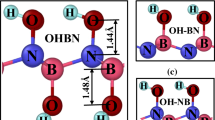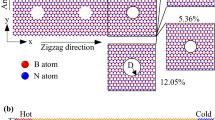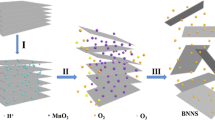Abstract
In this paper, classic mechanics-based approach was employed to predict the effect of crack edge passivation using different groups, viz. H, OH on the fracture properties of hexagonal boron nitride nanosheets (BNNS). The interaction between atoms was captured using reactive force field (ReaxFF) potential. In order to investigate fracture phenomenon in crack edge passivated BNNS, fully passivated configurations (H and OH radicals were attached to both sp hybridized N and B atoms) were considered. It was deduced from the results that the passivation of crack edge atoms in BNNS with various groups has enhancing effects on the fracture toughness in zigzag (ZZ) loading direction, while passivation has deteriorating effects in armchair (AC) loading direction. Results observed from this study will be utilizing the full capacity of BNNS nanosheets in different applications, e.g., nano-membrane for ion separation, drug delivery, nanocomposite, etc.
Access this chapter
Tax calculation will be finalised at checkout
Purchases are for personal use only
Similar content being viewed by others
References
Sharma BB, Parashar A (2019) Mechanical and fracture behaviour of hydroxyl functionalized h-BN nanosheets. J Mater Sci 55:3228–3242
Verma PK, Sharma BB, Chaurasia A, Parashar A (2020) Inter-granular fracture toughness of bi-crystalline graphene nanosheets. Diam Relat Mater 102:107667
Sharma SS, Sharma BB, Parashar A (2019) Mechanical and fracture behavior of water submerged graphene. J Appl Phys 125:215107
Sharma SS, Sharma BB, Parashar A (2019) Defect formation dynamics in dry and water submerged graphene nanosheets. Mater Res Express 6:075063
Mortazavi B, Pereira LFC, Jiang JW, Rabczuk T (2015) Modelling heat conduction in polycrystalline hexagonal boron-nitride films. Sci Rep 5:1–11
Sharma BB, Parashar A (2019) A review on thermo-mechanical properties of bi-crystalline and polycrystalline 2D nanomaterials. Crit Rev Solid State Mater Sci 45:134–170
Watanabe K, Taniguchi T, Kanda H (2004) Direct-bandgap properties and evidence for ultraviolet lasing of hexagonal boron nitride single crystal. Nat Mater 3:404
Sharma BB, Parashar A (2019) Atomistic simulations to study the effect of grain boundaries and hydrogen functionalization on the fracture toughness of bi-crystalline h-BN nanosheets. Phys Chem Chem Phys 21:13116–13125
Zhi C, Bando Y, Tang C, Golberg D (2010) Boron nitride nanotubes. Mater Sci Eng R Rep 70:92–111
Chen X, Wu P, Rousseas M, Okawa D, Gartner Z (2009) Boron nitride nanotubes are noncytotoxic and can be functionalized for interaction with proteins and cells. J Am Chem Soc 131:890–891
Lin Z, Liu Y, Raghavan S, Moon KS, Sitaraman SK, Wong CP (2013) Magnetic alignment of hexagonal boron nitride platelets in polymer matrix: toward high performance anisotropic polymer composites for electronic encapsulation. ACS Appl Mater Interfaces 5:7633–7640
Chaurasia A, Verma A, Parashar A, Mulik RS (2019) Experimental and computational studies to analyze the effect of h-BN nanosheets on mechanical behavior of h-BN/polyethylene nanocomposites. J Phys Chem C 123:20059–20070
Roosta S, Nikkhah SJ, Sabzali M, Hashemianzadeh SM (2016) Molecular dynamics simulation study of boron-nitride nanotubes as a drug carrier: from encapsulation to releasing. RSC Adv 6:9344–9351
Ghorbanzadeh Ahangari M (2015) Modeling of the interaction between polypropylene and monolayer sheets: a quantum mechanical study. RSC Adv 5:80779–80785
Sharma BB, Parashar A (2020) Mechanical strength of a nanoporous bicrystalline h-BN nanomembrane in a water submerged state. Phys Chem Chem Phys DOI: 10.1039/D0CP03235B
Sharma BB, Parashar A (2019) Atomistic simulations to study the effect of water molecules on the mechanical behavior of functionalized and non-functionalized boron nitride nanosheets. Comput Mater Sci 169:109092
Kong D, Zhang D, Guo H, Zhao J, Wang Z, Hu H, Xu J, Fu C (2019) Functionalized boron nitride nanosheets/poly(l-lactide) nanocomposites and their crystallization behavior. Polymers (Basel) 11:440
Sainsbury T, Satti A, May P, Wang Z, McGovern I, Gun’ko YK, Coleman J (2012) Oxygen radical functionalization of boron nitride nanosheets. J Am Chem Soc 134:18758–18771
Bhattacharya A, Bhattacharya S, Das GP (2012) Band gap engineering by functionalization of BN sheet. Phys Rev B—Condens Matter Mater Phys. 85:1–9
Weng Q, Wang B, Wang X, Hanagata N, Li X, Liu D, Wang X, Jiang X, Bando Y and Golberg D (2014) Highly water-soluble, porous, and biocompatible boron nitrides for anticancer drug delivery. ACS Nano 8:6123–30
Kumar R, Mertiny P, Parashar A (2016) Effects of different hydrogenation regimes on mechanical properties of h-BN: a reactive force field study. J Phys Chem C 120:21932–21938
**ao F, Naficy S, Casillas G, Khan MH, Katkus T, Jiang L, Liu H, Li H, Huang Z (2015) Edge-hydroxylated boron nitride nanosheets as an effective additive to improve the thermal response of hydrogels. Adv Mater 27:7196–7203
Kumar R, Parashar A (2017) Fracture toughness enhancement of h-BN monolayers via hydrogen passivation of a crack edge Nanotechnology 28
Van Duin ACT, Dasgupta S, Lorant F, Goddard WA (2001) ReaxFF: A reactive force field for hydrocarbons. J Phys Chem A 105:9396–9409
Paupitz R, Junkermeier CE, van Duin ACT, Branicio PS (2014) Fullerenes generated from porous structures. Phys Chem Chem Phys 16:25515–25522
Wei X, **ao S, Li F, Tang D, Chen Q, Bando Y (2015) Comparative fracture toughness of multilayer graphenes and boronitrenes. Nano Lett 15:689–694
Author information
Authors and Affiliations
Corresponding author
Editor information
Editors and Affiliations
Rights and permissions
Copyright information
© 2021 Springer Nature Singapore Pte Ltd.
About this paper
Cite this paper
Sharma, B.B., Parashar, A. (2021). Fracture Toughness Enhancement of Boron Nitride Nanosheets via Crack Edge Passivation Using Various Radicals. In: Saran, V.H., Misra, R.K. (eds) Advances in Systems Engineering. Lecture Notes in Mechanical Engineering. Springer, Singapore. https://doi.org/10.1007/978-981-15-8025-3_12
Download citation
DOI: https://doi.org/10.1007/978-981-15-8025-3_12
Published:
Publisher Name: Springer, Singapore
Print ISBN: 978-981-15-8024-6
Online ISBN: 978-981-15-8025-3
eBook Packages: EngineeringEngineering (R0)




